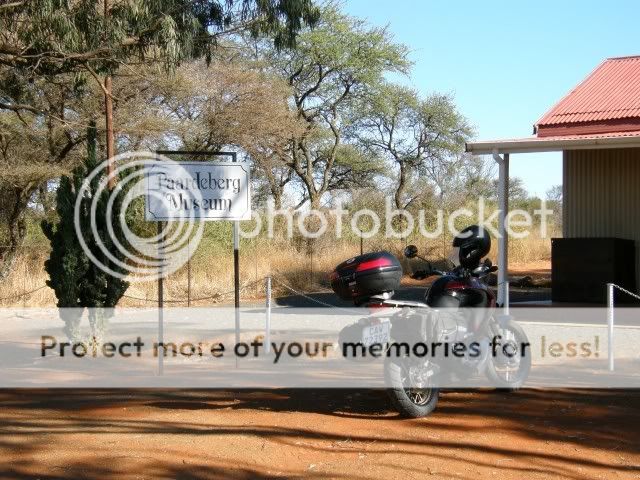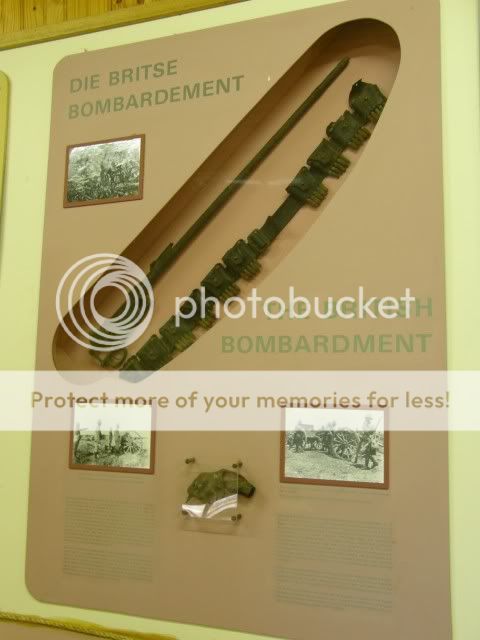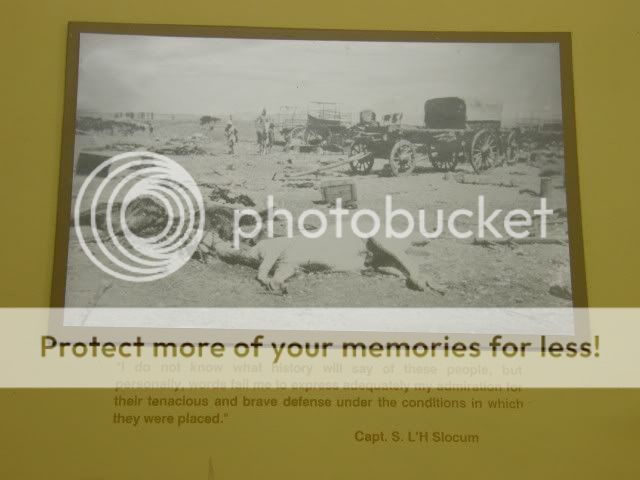Trailrider
Bachelor Dog
The museum of the Battle of Paardeberg is well worth a visit. Entry to the Museum is R2
 The museum is very informative with scale models of the battle, as well as some artistic impressions and relics collected from the site.
The museum is very informative with scale models of the battle, as well as some artistic impressions and relics collected from the site.

Battle of Paardeberg
Size of the armies: 15,000 British troops against 7,000 Boers.
On 15 February, Cronje's men finally evacuated their laager at Jacobsdal (close to Magersfontein). Their position was redundant and they were in danger of being outflanked. On the 17th, the large convoy of Boer wagons reached the crossing of the Modder river at Paardeberg Drift. They were starting to cross the river when a force of British mounted troops opened fire on them unexpectedly from the north, causing confusion.
Cronje then inadvisedly decided to form a laager and dig in on the banks of the Modder river. His reason for doing so are unclear. The British now outnumbered his force significantly and enjoyed overwhelming superiority in artillery. Lieutenant General Thomas Kelly-Kenny of the British 6th Division had a sound plan to lay siege to Cronje and bombard his force into surrender. This would almost certainly have proved successful and cost the British very few casualties.
However, Kitchener was now in overall command of the British force. He had different plans, and overruled Kelly-Kenny. He decided that Cronjé's position must be taken by storm immediately. This was despite the fact that the cost of frontal assaults against entrenched Boers had been demonstrated time and again the preceding months. It was no different this time. The British were shot down in their droves. It is thought that not a single British soldier got within 200 yards of the Boer lines. By nightfall some 24 officers and 279 men were killed and 59 officers and 847 men wounded. Judged by British casualties it was the most severe reverse of the war and became known as Bloody Sunday.
But seen from the Boer side, things were also bad. Cronjé and his men had been in headlong retreat for several days with the British snapping at their heels. While casualties from the bombardment had been reduced to around 100 dead and 250 wounded by the soft bank of the Modder, the horses, oxen and wagons had no trenches in which to shelter. Many wagons were destroyed. Ammunition exploded and stores were ruined. For many of the Burghers, these wagons carried the sum total of their worldly possessions. The loss of their horses was even worse, for the horse was almost as important to the fighting ability of a Boer as his Mauser. The morale in Cronjé's laager was desperate.
The sun came up and General Roberts now arrived on the scene. He initially urged a resumption of the frontal assaults but Cronje requested a cease-fire to bury the dead. The British refused (to their shame, as the Boers has allowed such truces in the past) and Cronje replied "Bombard as you will".
On February 27, 1900, the Boers surrendered. Cronje surrendered with some 4,019 men and 50 women. It was the first Brittish (and some would argue only) great victory of the war.



The monument at the site, again with a list of names of the fallen soldiers.

The site today:



Battle of Paardeberg
Size of the armies: 15,000 British troops against 7,000 Boers.
On 15 February, Cronje's men finally evacuated their laager at Jacobsdal (close to Magersfontein). Their position was redundant and they were in danger of being outflanked. On the 17th, the large convoy of Boer wagons reached the crossing of the Modder river at Paardeberg Drift. They were starting to cross the river when a force of British mounted troops opened fire on them unexpectedly from the north, causing confusion.
Cronje then inadvisedly decided to form a laager and dig in on the banks of the Modder river. His reason for doing so are unclear. The British now outnumbered his force significantly and enjoyed overwhelming superiority in artillery. Lieutenant General Thomas Kelly-Kenny of the British 6th Division had a sound plan to lay siege to Cronje and bombard his force into surrender. This would almost certainly have proved successful and cost the British very few casualties.
However, Kitchener was now in overall command of the British force. He had different plans, and overruled Kelly-Kenny. He decided that Cronjé's position must be taken by storm immediately. This was despite the fact that the cost of frontal assaults against entrenched Boers had been demonstrated time and again the preceding months. It was no different this time. The British were shot down in their droves. It is thought that not a single British soldier got within 200 yards of the Boer lines. By nightfall some 24 officers and 279 men were killed and 59 officers and 847 men wounded. Judged by British casualties it was the most severe reverse of the war and became known as Bloody Sunday.
But seen from the Boer side, things were also bad. Cronjé and his men had been in headlong retreat for several days with the British snapping at their heels. While casualties from the bombardment had been reduced to around 100 dead and 250 wounded by the soft bank of the Modder, the horses, oxen and wagons had no trenches in which to shelter. Many wagons were destroyed. Ammunition exploded and stores were ruined. For many of the Burghers, these wagons carried the sum total of their worldly possessions. The loss of their horses was even worse, for the horse was almost as important to the fighting ability of a Boer as his Mauser. The morale in Cronjé's laager was desperate.
The sun came up and General Roberts now arrived on the scene. He initially urged a resumption of the frontal assaults but Cronje requested a cease-fire to bury the dead. The British refused (to their shame, as the Boers has allowed such truces in the past) and Cronje replied "Bombard as you will".
On February 27, 1900, the Boers surrendered. Cronje surrendered with some 4,019 men and 50 women. It was the first Brittish (and some would argue only) great victory of the war.



The monument at the site, again with a list of names of the fallen soldiers.

The site today:





